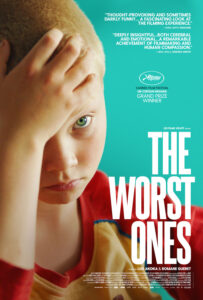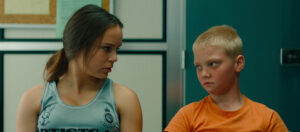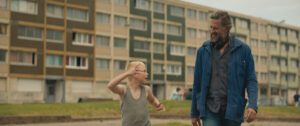Film Review: “The Worst Ones” Offers Raw, Emotional Complexity
Written by: Hannah Tran | March 24th, 2023

The Worst Ones (Lise Akoka/Romane Gueret, 2023) 3 out of 4 stars.
Laid out in a gripping opening sequence of “auditions,” The Worst Ones follows four teens from a poor neighborhood in France after they are cast in a film by Belgian director Gabriel, who gives them roles that amplify their reputation as troubled kids. The title is a phrase we hear early on when one of the child performers asks why the crew wanted to cast “the worst ones.” It’s a phrase that echoes throughout the rest of this complicated, semi-meta exploration of the ethics of casting non-professional child actors. With an engaging style that inches toward documentary and tremendous performances from its central young ensemble, The Worst Ones is a well-crafted film that trudges into its murky moral depths with a moving emotional resilience but a certain lack of self-awareness.
What works most is that there is no clear-cut right and wrong. The child actors are not merely victims and the film crew is not made out to be evil, but there are many times when the fine line between exploration and exploitation is crossed or is about to be. What’s so well-written about all of these relationships is the way that each individual party’s perspective is made understandable. The filmmakers within the film are forced to deal with the often genuinely offensive habits and ideas ingrained in the children while maintaining peace on set and getting their bottom line. Neighborhood locals are worried that the film creates a stereotype of their home. Meanwhile, the children and teens that are the stars of the film don’t really have a say in any of it.

The realism and the discomfort of all these gray areas are what make the movie so emotionally complex. However, the film-within-a-film setup leads to some even murkier questions about the film’s ethical responsibilities that are never fully confronted. The directing duo behind the film, Lise Akoka and Romane Gueret, founded their filmmaking careers in the casting department, and this experience served as the inspiration for this film. Their participation here, in which they are working creatively in ways that reflect the fictional film crew, weakens the more critical elements through their seeming hypocrisy. This may be another way to emphasize the gray area of the film’s moral code, but, for better or worse, it never presents any answers to its own questions.
The central quartet of young actors at the center, however, seem fully on board. Timéo Mahaut and Mallory Wanecque, who emerge as the primary duo, are wonderfully natural in their portrayal of both the pains and joys of their characters. In the role of director Gabriel, actor Johan Heldenbergh plays off of them brilliantly, ranging from likable to pathetic to dictatorial within minutes. While the story may be lacking in terms of clarity, and the various plot threads feel overly convenient to the conceit, the writing succeeds in allowing these performers the space within powerful, drawn-out scenes to truly unravel their characters’ personalities.

Although it sometimes begs for a more direct clash with the questions it poses, The Worst Ones is a quiet and empathetic film that tables the discussion around it for the audience. With strong performances and direction, its critical focus on what has been oft-referred to as “poverty porn” ends up being an emotionally resonant character study that ultimately has its heart where it belongs: with the children.

